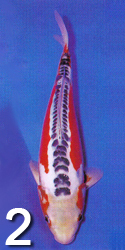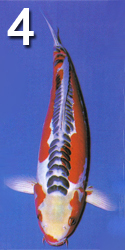Autumn Water Confirming the origins of Nishikigoi can often be a frustrating task, confused by both myth and conflicting information. Recorded history, however, credits Mr. Kichigoro Akiyama with being the first koi breeder to cross the German scaleless food carp with the Japanese Asagi, creating the first “Doitsugoi”, or scaleless Nishikigoi. Mr. Akiyama’s first attempt in 1911 produced a smooth skinned koi that had orange-red markings below the lateral line, and a blue colored back that was accented by a bold line of over-sized dark scales, starting behind the head and running the length of the backbone. The overall effect was quite striking, reminding it’s creator of the reflection of the autumn colors of the Japanese maple leaves on the water, thus inspiring the name Shusui, which means “Autumn Water”. The brilliant blue color that appears on the back is a characteristic that attract many a koi lover to young koi of this variety. Unfortunately this color seldom lasts beyond the second year for as the Shusui matures, the brilliant blue of the juvenile changes to a pale, almost light-gray/blue as is evidenced in the pictorial documentation of the yearling to 3 year old (#1 to #2).
The markings on this particular specimen are regarded as a classic example of Shusui, with red on both sides and at the base of the pectoral fins (moto aka), a bold, well aligned row of large scales (oni goke) on the back, and an unblemished white head. Other recognized pattern variations are Hana Shusui (#3) and Hi Shusui (#4). Hana Shusui, which translates as “Flower” Shusui, have a flowery red pattern on their back, whereas Hi Shusui (which translates as “Fire” Shusui ) have red that dominates the body
Note that as a yearling (#1), the young Shusui looked as if it was going to have a dark head, which is considered an undesirable feature for this variety. This darkness in the head is quite common in juvenile Shusui and as evidenced in the second photo (#2), it often clears up as the Shusui matures. On the other hand, a major problem with Shusui, as with Asagi and Goshiki, is that depending on their bloodlines and the environment in which they are kept, they can have a tendency to become extremely dark in the area of the head and back. It has been my experience that Shusui with a grayish undertone in the head like photo #5, are more likely to darken with age, while those with a more flesh-toned head like numbers 2,3 and 4 are less likely to change. Another change that commonly occurs with Shusui is the increase in the amount of red as the koi matures. Referring to photos 6 and 7: Two years after it took the “Best in Variety” award in the All Japan Show, new red markings appeared and the pectoral fins, head, nose, dorsal line and tail of this particular example. Note also the slight darkening in the area of the shoulders.
Like all other koi, Shusui will respond to an excellent environment and good nutrition by improving in vivacity and brilliance, ever reminding koi keepers to continue in their pursuit of the perfect pond. Copyright 2000 All rights reserved Joel Burkard/Pan Intercorp
BACK TO TOP |
||||||||||||||||||||||||
|
|
||||||||||||||||||||||||







